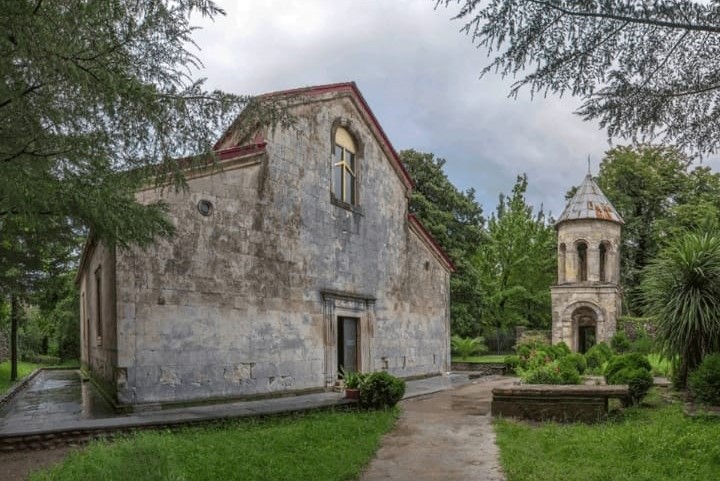Traditional Crafts in Georgia: A Short Historical Overview
2. Ceramic vessels from Zveli and Atskuri burial Grounds, 16th-15th century BC, Samtskhe-Javakheti Museum (Akhaltsikhe) 3. Wooden details from Mountainous Adjara, Kemal Turmanidze Ethnographic Museum "Borjgalo" (Batumi) 4. Costume from Khevsureti, 19th century
Traditional arts and crafts are an integral part of the cultural diversity of Georgia, and every region has its own characteristics, based on natural resources and traditional ways of life. The most widespread crafts in Georgia include metalworking, enameling, ceramics, wood and stone carving, leatherworking, as well as a rich textile tradition, which combines many different techniques, among them embroidery, weaving, felting, carpet-weaving, and woodblock printing. All of these crafts have a long history in Georgia with a variety of techniques and styles, which we will briefly review below.
Thanks to the land’s rich natural resources, metallurgy developed early in Georgia, with a number of different artistic metalworking techniques appearing in the Early Bronze Age, as early as the fourth or third millenium BCE. Archaeological findings from the period of the Mtkvar-Araxes culture (3500–2400 BCE) indicate a high level of skill in working with metal, which was further developed in the Middle Bronze Age, in the so-called Kurgan (hill-burial) culture. This is evidenced by the archaeological discoveries in the areas near Martq’opi and Bedeni, Ior-Alazni, and the Trialeti burial mounds. This research has confirmed the ancient knowledge in Georgia of techniques such as lost-wax casting; granulation (soldering/welding miniature balls); filigree (making an ornament by twisting metal wire); repoussé work (creating a low relief by hammering a sheet of metal from the reverse side); and inlaying (setting precious and semi-precious stones into metal).
Starting in the Late Bronze and Early Iron Age (fourteenth through seventh centuries BCE) the local Caucasian “animal style,” featuring stylized depictions of deer, birds, and other fantastic animals, can be found in the decoration of axes from the Colchis (west Georgian) culture, and later on engraved bronze belts and ornamental buckles. The rich discoveries in Vani and Siarkhe also indicate the development of metalworking techniques in Colchis in from the sixth to third centuries BCE. Necklaces, diadems, headpieces, earrings, and other burial items from this period display beautiful decorations, expertly executed using the gold granulation technique.

Headdress, Vani, 2nd Half of the 4th century BC, Georgian National Museum
Eastern Georgia (Iberia) was no less impressive in the fourth century BCE, in particular in the areas of Akhalgori and Mtskheta, where both oriental and ancient Mediterranean influences come together. In Mtskheta the goldsmithing of this period is characterized by the use of cloisonné inlay, which is supplemented with filigree and granulation. Of particular interest are glyptic techniques (engraving on precious and semi-precious stones), which spread under the influence of the ancient Greco-Roman world, in particular the popularity of cameo (a raised image on a low background) and intaglio (an image incised into the background). After Christianity was adopted as the state religion of Rome in the fourth century CE, the repoussé arts were given a leading role in the production of icons, crosses, and other religious items. The masterpieces of Georgian engraving from the early-to-high Middle Ages include the oldest icon of the Transfiguration from Zarzma, dated to 886, as well as the Bedia Chalice, the cross of Martvili, the plates of Sagholasheni and Shemokmedi, the tondo with the figure of St. Mammes, the altar cross from Mestia, the icon of the Mother of God commissioned by Laklakidze family, and many others, all of which date back to end of the tenth and beginning of the eleventh centuries.
From the twelfth century, Georgian goldsmithing became even more decorative, the best example of which is the Khakhuli triptych, with its 115 enamel details and a central image which is the world’s largest example of partitioned enamel. Thanks to this richness of material and technique, the icon is often referred to as a “museum of cloisonné enamel.”
Especially impressive are the works of Beka and Beshken Opizaris—famous Georgian goldsmiths from the time of Tamar the Great (r. 1184 –1213)—which are distinguished by their refined proportions, full-dimensional figures, flowing silhouettes, and the plasticity of ornamental patterns.
After the era of Queen Tamar, and as a result of constant invasions, the development of Georgian metalwork was interrupted, although there were still several important centers of the art in the fifteenth through eighteenth centuries. In western Georgia there was the workshop of Levan Dadiani and in eastern Georgia the “Kakheti school,” which was distinguished by its own special technique of gold engraving. From the Middle Ages through the eighteenth and nineteenth centuries, important centers of goldsmithing were in Rach’a (particularly smithing) and Svaneti, which had its own local tradition of engraving and jewelry.
Beginning around the turn of the nineteenth century, Tbilisi became the leading center of goldsmithing. In this period, an artistic technique combining niello (black decoration made from a sulfurous silver alloy), damascening (inlaying gold wire into an engraved artwork), filigree, and granulation became widespread. It was used to decorate weapons, jewelry, and utensils. Nineteenth-century silver wine vessels from Tbilisi are worthy of special mention: azarpeshas (silver drinking cups with a handle), repoussé cups, qarqaris (pouring jugs) and other containers were decorated with ancient archetypal faces, animals, biblical and mythological characters, as well as contemporary scenes from Tbilisi depicting various characteristic patterns and urban life.
Ceramic arts have a long history in Georgia, originating in ancient times, and are especially distinguished by the variety of drinking vessels, which, in turn, are closely related to Georgia’s ancient tradition of winemaking. This can be seen in the regional variety of kvevri (large clay jars for fermenting, storing, and aging of wine) and other vessels, with unique local styles: khelada (a type of round-bellied jug), doki (pitcher), piala (drinking bowl), sura (narrow-necked pitcher), marani (a kind of pitcher composed of smaller interconnecting vessels) and other sharing receptacles. The almost constant use of these forms over the millennia indicates the existence of sustainable local traditions.
The first examples of pottery date back to the Neolithic period, from the eighth millennium BCE. Starting in the early Bronze Age (third millennium BCE), there is a clear trajectory of development from simple pottery to the sophisticated variants of smoke-fired ceramics with zoomorphic elements.

Ceramic vessels from Zveli and Atskuri burial Grounds, 16th-15th century BC, Samtskhe-Javakheti Museum (Akhaltsikhe)
While the pottery of the pre-Christian era was mostly made without glaze (the glass-like layer that covers the surface of the ceramic piece), in the medieval period glaze became prevalent in the decoration of ceramics: jars, bowls, cups, saucers, saltshakers, were painted with glaze that was colored green, light blue or light burgundy, and somewhat more rarely, dark blue glaze. The main patterns were crosses and birds, done in a style informed by the influence of oriental ceramics.
The production of clay vessels especially developed in the nineteenth and early twentieth centuries, when there were about fifty centers in Georgia, mostly in the territories of Kakheti, Imereti, and Shida Kartli. Glazed ceramics from Gori were especially popular during this period. Most commonly made were a variety of interconnected vessels, decorated with greenish glaze ornaments and featuring animal and human figures on a white or yellow background.
The art of woodworking occupies a special place in both ecclesiastical art (for example, the carved doors of churches like those at Chuk’uli, Jakhunderi, Lashes-Vani, Mghvimevi, and others especially of the tenth and eleventh centuries), as well as in folk crafts and architecture. The uses of woodworking include halls with a central pillar in darbazi-type structures in Kartli or Meskheti; the interiors of Svan residences (machubi, with wood partitions for the cattle stalls); the decoration of Ach’aran mosques made by Laz masters; the architecture and balcony system of west Georgian odas (wooden houses on stone or wooden supports); and the old Tbilisi residential houses with overhanging wooden balconies, twisted columns, and carved wooden bannisters. Traveling masters from Rach’a, whose hands had made the balconies of the houses in Tbilisi and eastern Georgia, especially stood out among the wood craftsmen.
Wood carving was also widely used as in decorating home furniture and other household objects. Geometrical patterns adorned such items as armchairs, sak’artskhuli (a special chair for the head of the family in Svaneti and Rach’a), settees, chests, cradles, musical instruments (chonguri, salamuri), and tableware. Over the centuries, common motifs may be seen in the woodcarving of different regions, with geometric, astral, zoomorphic, and figurative patterns showing connections with folk beliefs and indicating their vitality.
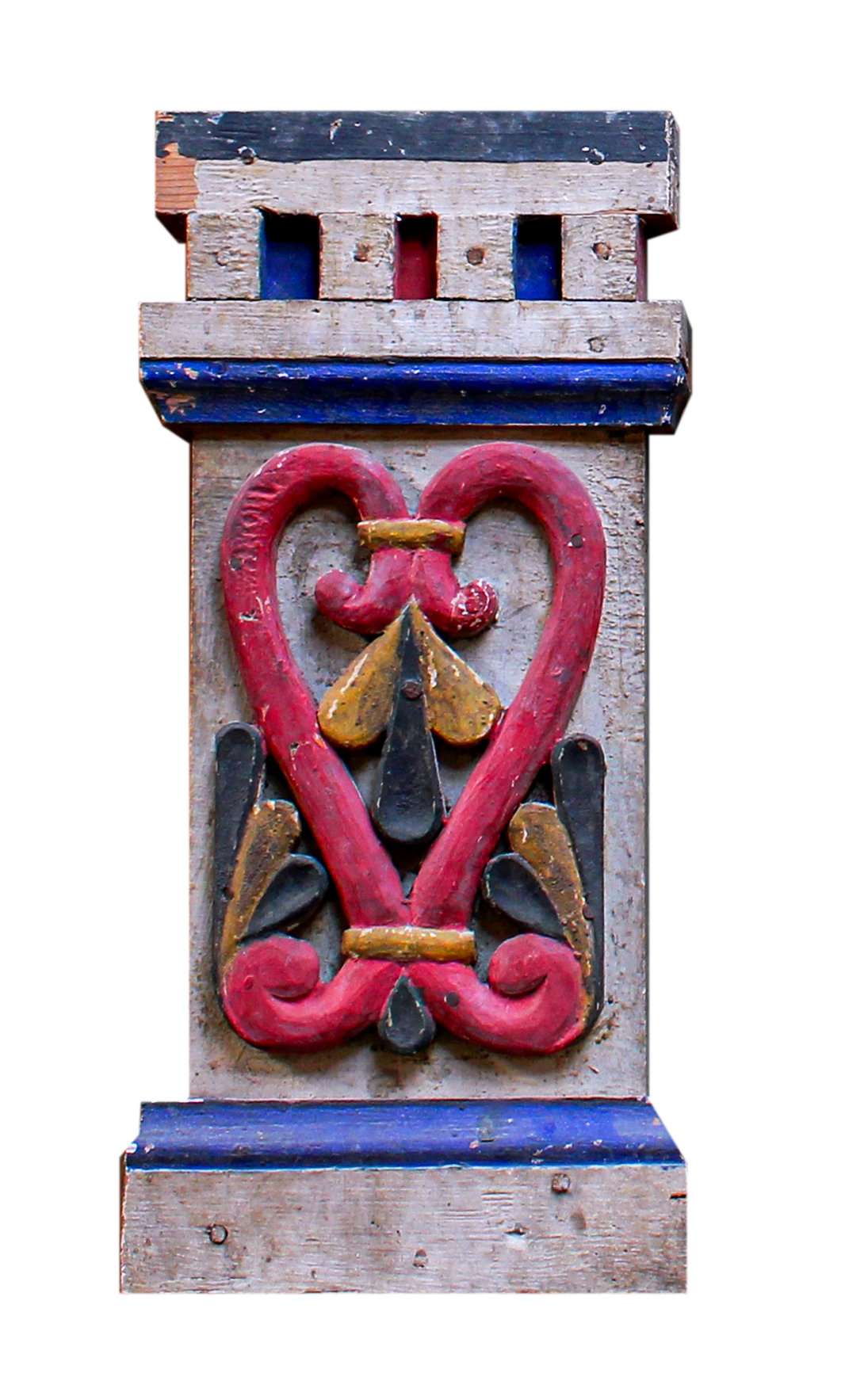 |
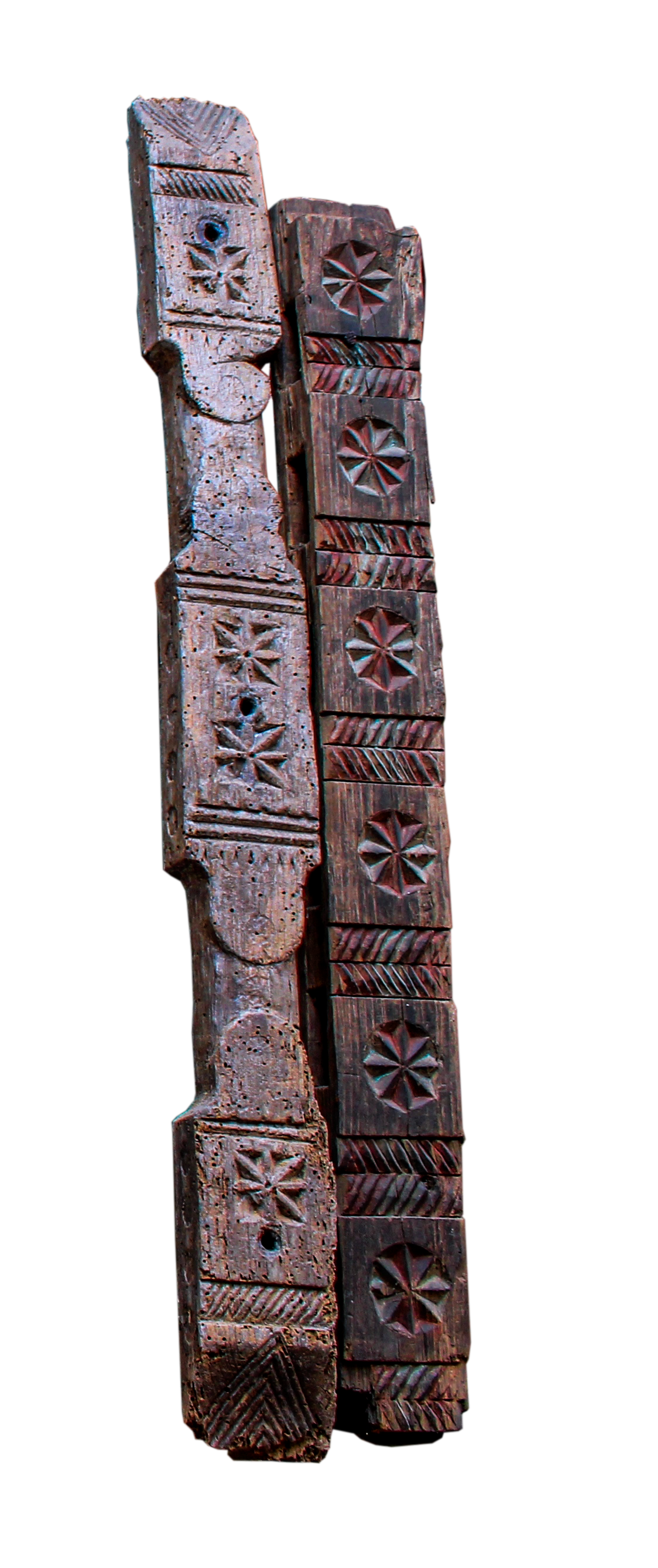 |
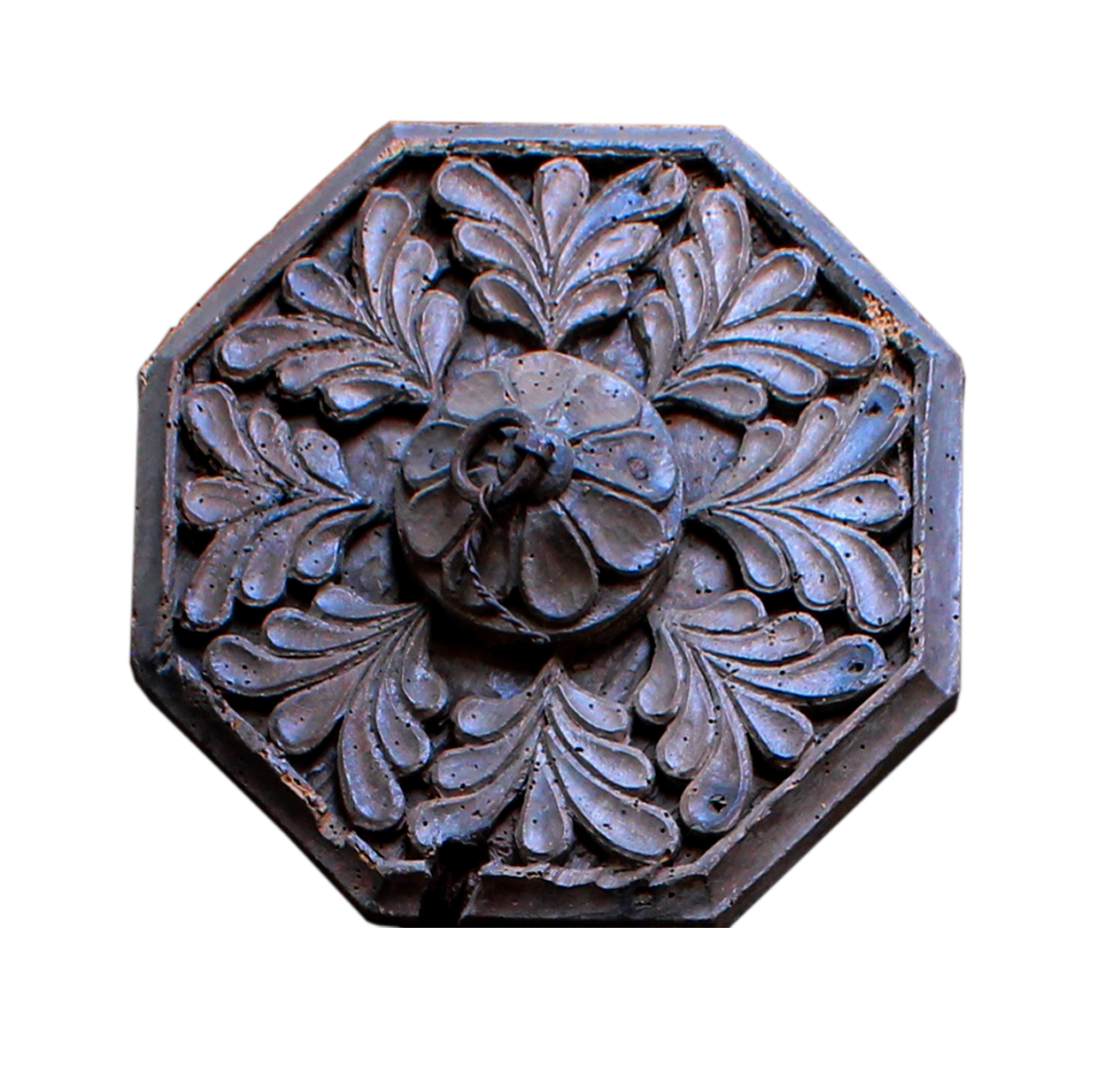 |
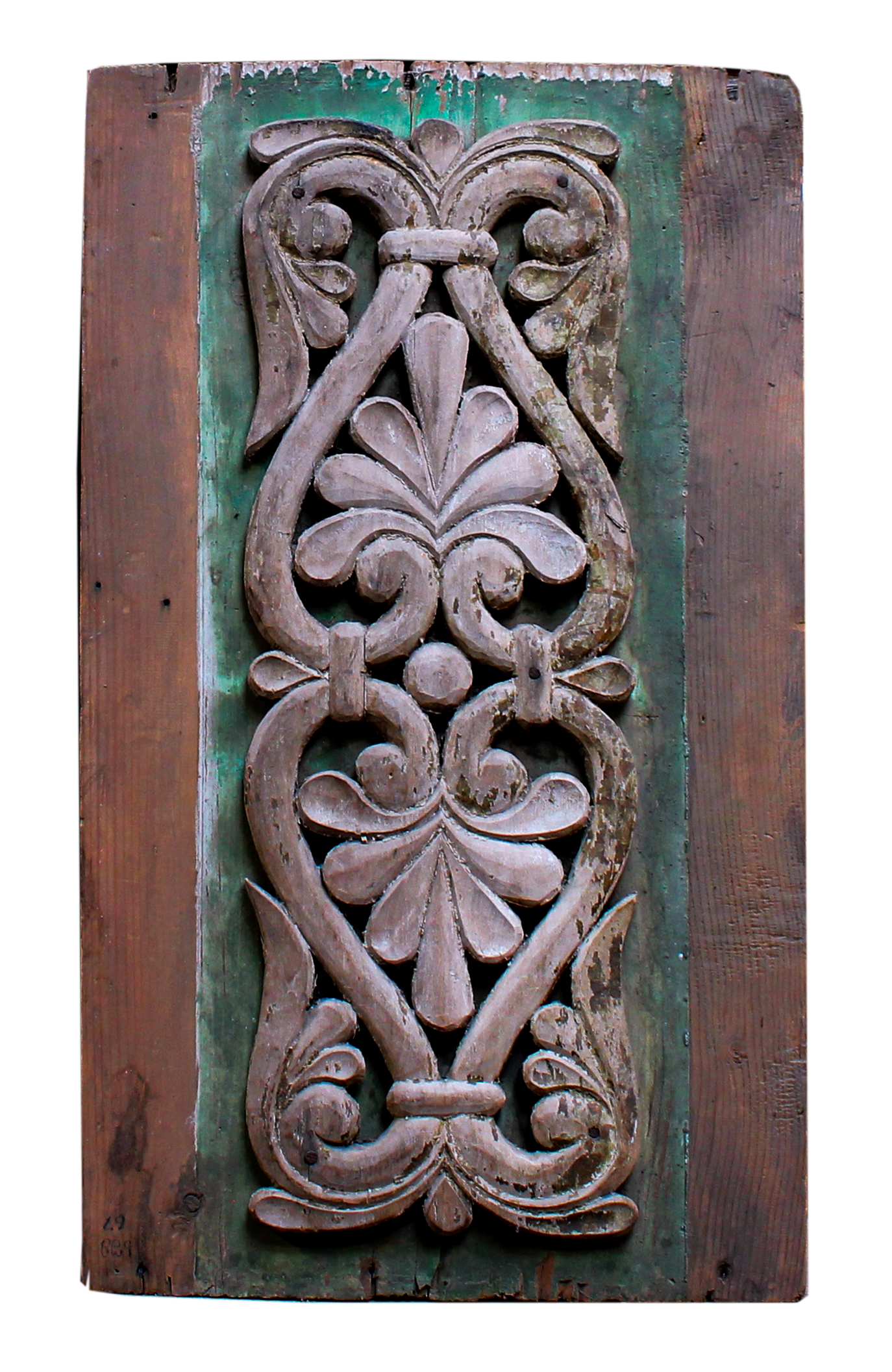 |
Wooden details from Mountainous Adjara, Kemal Turmanidze Ethnographic Museum "Borjgalo" (Batumi)
Along with woodworking, the most prominent branch of craftsmanship was stone carving, which was given special importance in the decoration of steles, church façades, and iconostases in medieval Georgia: from the expressive, low reliefs of the early Christian or transitional period, to the tenth and eleventh-century churches in Tao-Klarjeti, Nikortsminda, and Bagrati, to the richness and sophistication of the carvings of Svetitskhoveli and other cathedrals.
In terms of the folk traditions of stone carving, one can see doors of residential houses carved with stone reliefs, particularly in Rach’a, as well as elaborate fireplaces and tombstones, which were especially on the rise in the nineteenth century. At this time, the tradition of relief tombstone portraits, which depict in fascinating detail the clothes, accessories, and beliefs of that period, started to develop, in parallel with the extant tradition of zoomorphic carvings, particularly of sheep and horses.
When it comes to Georgian traditional crafts, textile arts deserve special mention, as the history of these techniques also dates far back into antiquity. This is confirmed by the discovery of a vertical weaving loom and weaving comb found at the Ilto settlement, which date back to the third millennium BCE, as well as ancient fragments of fabrics found at burial sites. Textile arts were also very important in the Middle Ages, as can be seen in the clothing worn by important figures in portraits of the time, as well as items used for liturgical purposes which have survived to today (tapestries decorated with gold borders depicting scenes like the deposition of Christ from the cross, priests’ vestments, etc.).
In Georgia, mastering needlework has long been considered a necessary duty for women. Young girls would learn weaving from childhood, by processing of wool, flax, hemp, or silk, and making dowry fabrics. The purpose of the dowry fabrics also determined the decorative motifs used, which addressed themes of fertility and family well-being.
Wool production centers were mainly located in mountainous regions, including Tusheti, Khevsureti, Pshavi, Svaneti, Zemo Rach’a, and Javakheti, etc.. Sheep bred specially for wool were particularly common in Tusheti. The centers of carpet production were in Samtskhe-Javakheti, Kvemo Kartli (Borchalo carpet), Kakheti, and Ach’ara. Rug-making techniques were particularly developed in Tusheti and Pshav-Khevsureti, while felting was mostly practiced in Tusheti, Svaneti and Rach’a. Georgia also had a notable tradition of silk weavers, whose history probably began in the fifth century CE and reached its peak in the nineteenth and twentieth centuries.
Textile decoration techniques played an important role in the adornment of the national dress, whether it was the long, gold-embroidered belts and classic “Georgian” dresses worn by women with accompanying headwear, or the clothing of the mountainous regions. In this regard, clothing from Khevsureti is especially distinguished: it is decorated with knitted fragments, cross-stitched and dashi embroidery, fine beads, and coins. An inseparable part of it were knitted socks, gloves, and mittens often made with the technique of dashibva (a supplementary weft-knitting technique).

Costume from Khevsureti, 19th century
In terms of textile designs, an important artistic phenomenon is the wood-printed blue tablecloth (lurji supra), which became especially popular in the nineteenth century. Birds, deer, fish, roses, and evergreen plants often appear in the designs, which are symbolically related to the ancient cult of the tree of life and, accordingly, to the themes of fertility and family well-being.
The diversity and regional variations in the decorative processing techniques of different materials are a testament to the rich traditions of folk crafts in Georgia. The continuous popularity of common ornamental motifs, which recur throughout the millennia, speak to the multi-level unity of folk memory.
Further reading:
1.Soltes, Ori Z. 1999. National Treasures of Georgia. London: Philip Wilson.
2.Burchuladze, Nana. 2023. Shua sauk’uneebis sakartvelos krist’ianuli khelovnebis sagandzuri (Treasury of Christian art of the Georgian Middle Ages). Tbilisi: Sakartvelos erovnuli muzeumi.
3.Shanshiashvili, Ana. 2018. Old Tbilisian Silverware. Warsaw: Polish Scientific Publishers PWN.
4.Bakhtadze, Nodar, ed. 2013. Ceramics in Medieval Georgia. Tbilisi: Sulakauri.
5.Baratashvili, Gulnaz, et al. 2011. Kartuli nakargoba (Georgian embroidery). Tbilisi: Karchkhadze.
6.Koshoridze, Irina. 2016. Georgian Rug. Tbilisi: Georgian State Museum of Folk and Applied Art.


.jpg)

